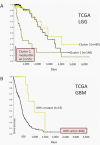The UCSC Cancer Genomics Browser: update 2015
- PMID: 25392408
- PMCID: PMC4383911
- DOI: 10.1093/nar/gku1073
The UCSC Cancer Genomics Browser: update 2015
Abstract
The UCSC Cancer Genomics Browser (https://genome-cancer.ucsc.edu/) is a web-based application that integrates relevant data, analysis and visualization, allowing users to easily discover and share their research observations. Users can explore the relationship between genomic alterations and phenotypes by visualizing various -omic data alongside clinical and phenotypic features, such as age, subtype classifications and genomic biomarkers. The Cancer Genomics Browser currently hosts 575 public datasets from genome-wide analyses of over 227,000 samples, including datasets from TCGA, CCLE, Connectivity Map and TARGET. Users can download and upload clinical data, generate Kaplan-Meier plots dynamically, export data directly to Galaxy for analysis, plus generate URL bookmarks of specific views of the data to share with others.
© The Author(s) 2014. Published by Oxford University Press on behalf of Nucleic Acids Research.
Figures


References
-
- Hanahan D., Weinberg R.A. Hallmarks of cancer: the next generation. Cell. 2011;144:646–674. - PubMed
-
- Chin L., Andersen J.N., Futreal P.A. Cancer genomics: from discovery science to personalized medicine. Nat. Med. 2011;17:297–303. - PubMed
-
- Merali Z. Computational science: …Error. Nature. 2010;467:775–777. - PubMed

